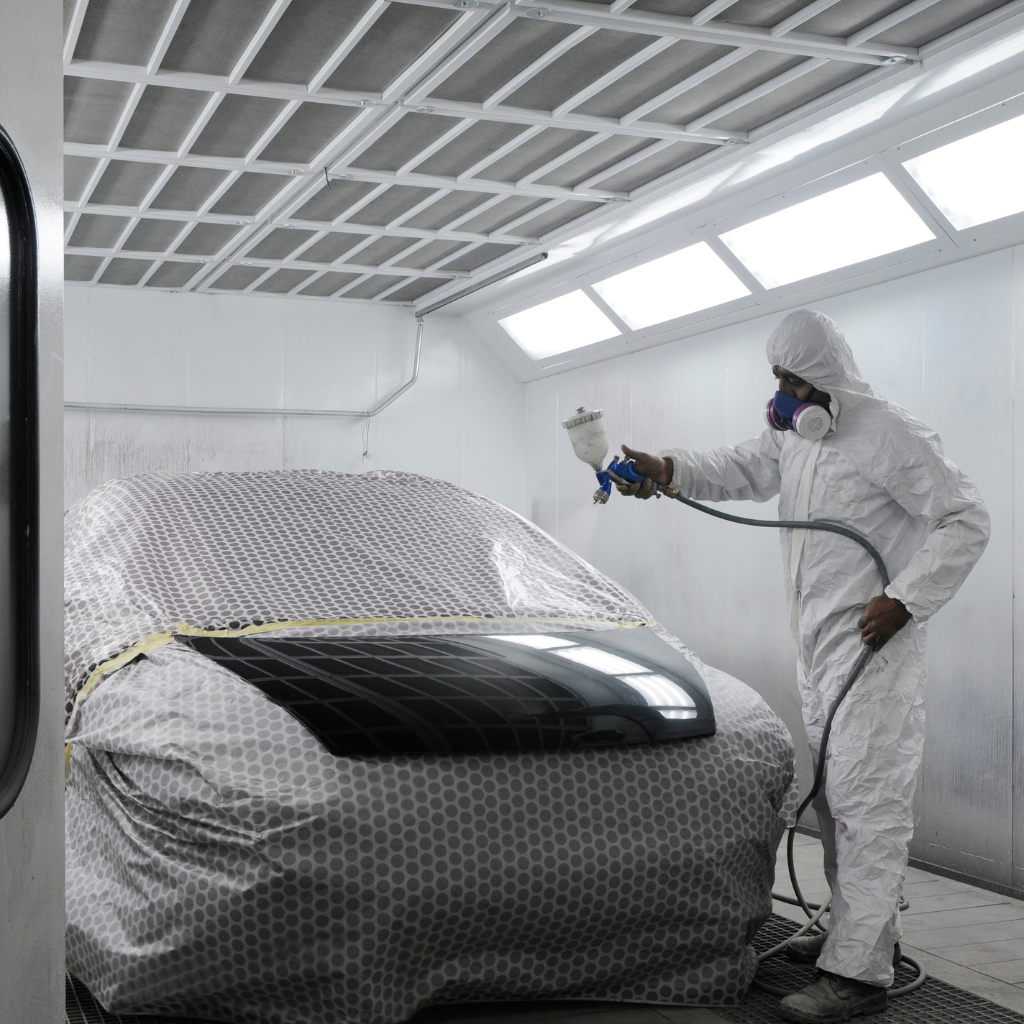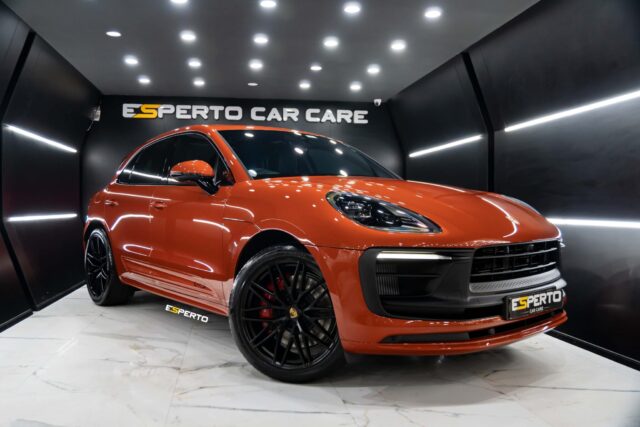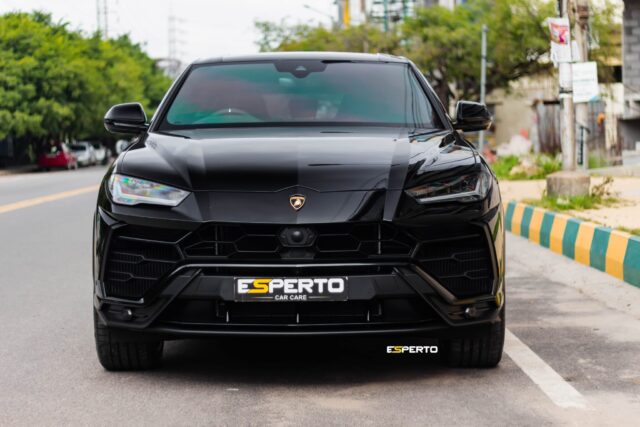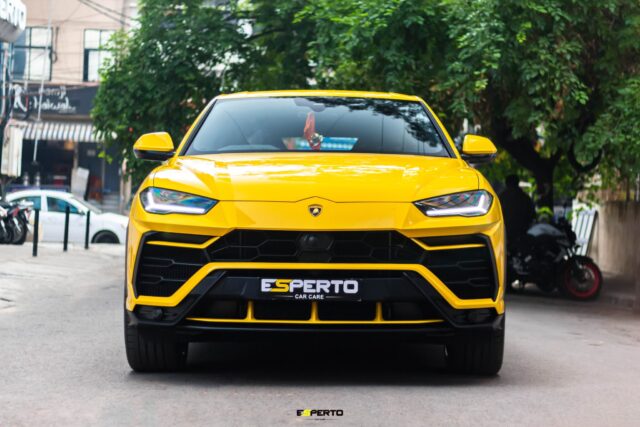Ceramic coating offers substantial protection against UV rays, sun exposure, and heat, effectively preserving a car’s paint job by repelling harmful solar radiation and mitigating paint fading. The coating’s silicon dioxide base forms a durable barrier that reflects ultraviolet light and withstands high temperatures, which helps maintain the vehicle’s aesthetic and structural integrity. Exploring further will reveal additional benefits and maintenance tips for maximizing the longevity and effectiveness of ceramic coatings.
Key Takeaways
- Ceramic coating contains silicon dioxide that reflects harmful UV rays, reducing sun damage to car paint.
- It serves as a barrier protecting against premature aging and paint fading due to sun exposure.
- The coating is designed to withstand high temperatures, safeguarding the vehicle from heat-related damage.
- Regular maintenance of ceramic coating extends its protective properties against UV rays and heat.
- Its hydrophobic nature repels water and contaminants, minimizing heat absorption and enhancing vehicle protection.
Does Ceramic Coating Protect Against UV and Prevent Paint Fading?
Ceramic coatings, enriched with silicon dioxide, form a robust layer on a car’s exterior, effectively shielding it from harmful ultraviolet rays.
This protective barrier not only prevents UV radiation from degrading the paint but also mitigates the risk of fading and oxidation over time.
Understanding the scientific foundation of ceramic coatings is essential for recognizing their effectiveness in preserving a vehicle’s aesthetic appeal and structural integrity.
Understanding the Science Behind Ceramic Coating
While many vehicle owners appreciate the aesthetic and protective benefits of ceramic coatings, understanding the scientific principles that underpin these effects is essential.
Ceramic coatings, primarily composed of nano ceramic coatings particles, form a robust protective barrier on the vehicle’s surface. This barrier considerably enhances UV protection by reflecting harmful UV rays that cause sun damage and paint fading.
The science behind ceramic coating reveals that these nano-sized particles provide a dense, tightly packed layer, offering substantial resistance against environmental aggressors. This molecular arrangement not only shields the paint from UV exposure but also contributes to the overall durability of the surface, maintaining the vehicle’s pristine appearance and upholding its protective qualities against the elements.
The Role of Silicon Dioxide in Ceramic Coatings
Silicon dioxide, commonly known as silica, plays an essential role in the efficacy of ceramic coatings applied to car surfaces. This compound forms the backbone of ceramic coatings, creating a liquid polymer that bonds with the car’s paint.
When cured, this blend forms a durable barrier on automotive surfaces, greatly enhancing paint protection. Silicon dioxide‘s properties contribute to the robustness of the coated surface, affording it resistance to various methods environmental pollutants.
Importantly, while this article focuses on the general protective qualities of ceramic coatings, including their ability to fortify the paint against degradation, the specific mechanics of UV protection and prevention of paint fading are detailed further in subsequent sections, emphasizing the extensive benefits of using ceramic coatings for long-term vehicle care.
Creating a Protective Barrier Against UV Rays
Although many drivers are aware of the general protective qualities of ceramic coatings, not all understand their specific ability to shield a vehicle’s paint from ultraviolet (UV) radiation.
Ceramic coatings offer superior UV protection, effectively blocking UV rays that can lead to premature aging and fading of a car’s exterior. Serving as a barrier against UV rays, these coatings provide a robust defense against the damaging effects of the sun.
The UV protection provided is integral to maintaining the vibrancy and integrity of the paint. By protecting from the sun, ceramic coatings guarantee that the vehicle not only retains its aesthetic appeal but also its value, acting as the ultimate shield against sun damage.
What Are the Benefits of Ceramic Coating for UV Protection?
Ceramic coatings offer significant UV protection for vehicles, mitigating sun damage that can fade and degrade paint over time, emphasizing the importance of proper maintenance.
This type of coating provides a durable barrier that is more long-lasting than traditional wax treatments, effectively preserving the vehicle’s aesthetic and structural integrity.
When compared to alternatives like paint protection film, ceramic coatings also stand out for their ability to resist environmental contaminants while maintaining a high-gloss finish.

Reducing Sun Damage to Your Vehicle
When considering methods to reduce sun damage to vehicles, ceramic coating emerges as a highly effective strategy due to its ultraviolet (UV) ray-blocking capabilities.
This innovative solution offers substantial protection for your car by mitigating the harmful effects of UV rays also enhancing water repellency. Ceramic coating provides a resilient barrier that shields the car paint from sun damage, preserving the vehicle’s aesthetic and structural integrity.
By reducing exposure to UV rays, the ceramic coating helps maintain the car’s luster and prevents the paint from fading and deteriorating prematurely.
Consequently, ceramic coating protects your car not only enhances the vehicle’s appearance but also contributes to long-term car paint protection, ensuring that the vehicle remains in pristine condition despite prolonged sun exposure.
How Ceramic Coating Provides Long-lasting Protection
Given its advanced technology, ceramic coating not only helps prevent sun damage but also offers long-lasting protection for car paints.
By forming a chemically resistant surface, ceramic coating shields the vehicle’s exterior from ultraviolet rays that can cause paint fading, especially on surfaces exposed to direct sunlight. This protective layer effectively blocks UV rays and reduces the degree of sun exposure that typically degrades a car’s paintwork over time.
The unique hydrophobic properties of ceramic coatings also contribute to their effectiveness, repelling water and contaminants that can further harm the surface.
Additionally, the heat resistance of ceramic coatings guarantees that they withstand harsh sunlight without degrading, preserving the integrity and appearance of the paint beneath.
This robust barrier extends the lifespan of the car’s exterior, maintaining its aesthetic appeal and structural resilience.
Can Ceramic Coatings Withstand Hot Weather?
Ceramic coatings are engineered to offer robust protection against various elements, including extreme heat; however, the performance can vary depending based on the coating’s quality and application.
In hot climates, maintaining a car’s paint involves regular inspections of the ceramic layer to verify it hasn’t degraded under prolonged exposure to high temperatures.
Over time, heat can potentially diminish the effectiveness of ceramic coatings, necessitating periodic reapplication to sustain peak protection.
Effects of Heat on Ceramic Coating
Although ceramic coatings are designed for durability, their performance in extreme heat warrants careful consideration.
Ceramic coating, a protective layer applied to a vehicle’s exterior, is generally resistant to high temperatures. However, extended exposure to direct sunlight and intense heat can potentially degrade its effectiveness.
The coating is engineered to protect against environmental hazards, including UV radiation, but continuous high temperatures may accelerate the breakdown of its chemical properties.
For maximum durability, it is essential to monitor the coating’s condition and look for signs of wear under such conditions. Regular assessments help guarantee the ceramic layer continues to shield the vehicle’s paint from heat-related damage effectively, maintaining its aesthetic appeal and protective functionality.
Maintaining Your Car’s Paint in Hot Weather
To maintain a car’s paint in hot weather, owners should consider the efficacy of ceramic coatings, which are designed to withstand high temperatures and help resist minor scratches.
Applying a ceramic coating can help protect your vehicle not only from UV rays but also from the intense heat that can degrade car paint over time. This protective layer serves as a barrier against environmental contaminants and reduces the damage they can cause.
Regular maintenance of the coating guarantees that it continues to shield the car’s appearance effectively. Moreover, the unique properties of ceramic coatings offer substantial protection, helping to preserve the overall aesthetics and value of the vehicle.
Owners seeking to safeguard their investments would find ceramic coatings a practical and beneficial choice in hot weather conditions.
How Heat Affects the Durability of Ceramic Coatings Over Time
Despite their robustness, ceramic coatings are subject to gradual degradation when exposed to prolonged high temperatures. The durability of ceramic coating is compromised as heat accelerates the breakdown of its protective properties.
This degradation process is exacerbated by additional exposure to UV rays and environmental hazards, which collectively can diminish the longevity of the ceramic coating. To mitigate these effects, it is essential to regularly inspect and maintain the coating, especially after periods of intense sun exposure.
Ceramic coatings also offer some level of defense against these elements, preserving the underlying surfaces of the car. However, for ideal protection and to extend the life of the coating, it is recommended to park vehicles in shaded or covered areas whenever possible.
Why is UV Protection Critical for Car Paint?
Ultraviolet (UV) rays can greatly degrade car paint over time, leading to fading, oxidation, and loss of gloss.
Ceramic coatings offer a protective barrier that reflects these harmful rays, thereby preserving the paint’s vibrancy and structural integrity.
Without such protection, UV exposure can cause irreversible damage to a vehicle’s exterior, necessitating costly repairs or repainting.

Understanding the Impact of UV Rays on Car Paint
In the automotive industry, the longevity and aesthetic appeal of a vehicle’s exterior are paramount. UVA rays, a component of sunlight, greatly contribute to the degradation of car paint. This type of ultraviolet light accelerates the oxidation process, leading to fading and dullness.
Prolonged sun exposure without adequate UV protection can also result in the breakdown of paint’s chemical bonds, causing cracking and peeling. Effective vehicle maintenance should include measures to mitigate these effects, as heat exacerbates the rate of deterioration.
Ceramic coatings are often compared for their protective qualities, but evaluating their specific capabilities in shielding paint from UV damage is vital for ensuring prolonged paint health and vibrancy.
How Ceramic Coating Protects Against UV Damage
Given the vulnerability of car paint to UV damage, ceramic coatings serve as a robust shield that blocks ultraviolet rays from penetrating the paint surface.
In the car industry, the utilization of ceramic coating for your car is increasingly recognized for its protective qualities. The coating chemically bonds with the car’s paint, creating a durable layer of protection. This layer is often enriched with titanium dioxide, a compound known for its UV filtering capabilities.
The benefits of ceramic coating extend beyond UV protection; it preserves the aesthetic integrity of the paint by preventing oxidation and fading. Consequently, applying a ceramic coating is a practical measure to safeguard your vehicle’s surface and maintain its showroom shine.
Can UV Rays Permanently Damage Your Car’s Paint?
UV rays can greatly damage car paint, leading to fading, oxidation, and the loss of a glossy finish. This is why UV protection is critical for maintaining the aesthetic and structural integrity of a car’s exterior. Ceramic coating acts as a shield, providing robust protection against UV rays. By applying a ceramic coating, car owners can guarantee that the paint is less susceptible to the degenerative effects of sun exposure. Automotive care experts recommend this type of coating not only to maintain the car’s appearance but also to assure its longevity. Proper care, including regular application and maintenance of the coating, is essential for ideal protection.
Is Applying a Ceramic Coating Worth the Investment?
Evaluating the cost-effectiveness of ceramic coatings involves analyzing both the initial investment and the potential savings on maintenance over time.
Deciding between professional application and DIY methods hinges on balancing cost with the quality and longevity of the coating achieved.
Ultimately, understanding the long-term value of ceramic coatings can determine if the expense is justified by the protective benefits and the preservation of the vehicle’s appearance.
Cost-Effectiveness of Ceramic Coating
Often, motorists question the cost-effectiveness of applying a ceramic coating to their vehicles, weighing whether the initial investment justifies the long-term benefits.
When considering professional ceramic coating services, the technical aspects reveal considerable advantages:
- UV Protection and Durability: Ceramic coating acts as a shield against UV rays, maintaining the paint’s integrity and preventing fading.
- Enhanced Scratch Resistance: With its hard surface, ceramic coating offers improved scratch resistance, safeguarding the vehicle’s exterior from minor abrasions.
- Low Maintenance Costs: The hydrophobic nature of ceramic coatings repels water and dirt, reducing the frequency and intensity of cleaning required.
Properly maintained, a ceramic coating can considerably enhance the overall performance and appearance of various materials used in car exteriors, making it a worthwhile long-term investment.
Professional vs. DIY Ceramic Coating Application
While many car owners recognize the benefits of ceramic coatings, deciding between a professional application and a do-it-yourself (DIY) approach requires understanding the distinct advantages and potential drawbacks of each method.
The professional vs. DIY ceramic coating application debate hinges on several factors. Professional application guarantees that the ceramic coating is applied correctly, leveraging their expertise in the composition of ceramic coatings and the meticulous application process that bonds with the factory paint. This assures a trusted ceramic coating outcome.
Conversely, DIY methods offer cost savings and personal satisfaction but may risk improper application.
Regardless of choice, the ceramic coating needs careful maintenance; for instance, owners should avoid automatic car washes to preserve the ceramic-coated surface.
Long-Term Value of Ceramic Coating: Is It Worth the Cost?
Considering the long-term value of ceramic coating, the benefits often outweigh the upfront costs. Ceramic coatings, a liquid polymer applied to the exterior of a vehicle, not only enhance the car’s appearance but also offer substantial protective advantages.
- Durability Against Elements: Ceramic coating protects against UV rays, repels water, and guards against other environmental hazards, reducing the likelihood of costly repairs.
- Maintenance Savings: The coating provides easier cleaning by creating a surface that dirt and grime have difficulty adhering to.
- Preservation of Vehicle’s Aesthetics: One of the best ways to protect and keep their car looking new is to preserve its resale value over time.
Conclusion
To sum up, ceramic coatings offer significant protection against UV rays, thereby extending the lifespan and preserving the aesthetic of car paint. By forming a robust barrier, they mitigate paint fading and damage due to sun exposure and heat. Considering the technical benefits, including reduced maintenance and enhanced durability, investing in a ceramic coating is a practical choice for car owners seeking to maintain their vehicle’s appearance and value over time.






